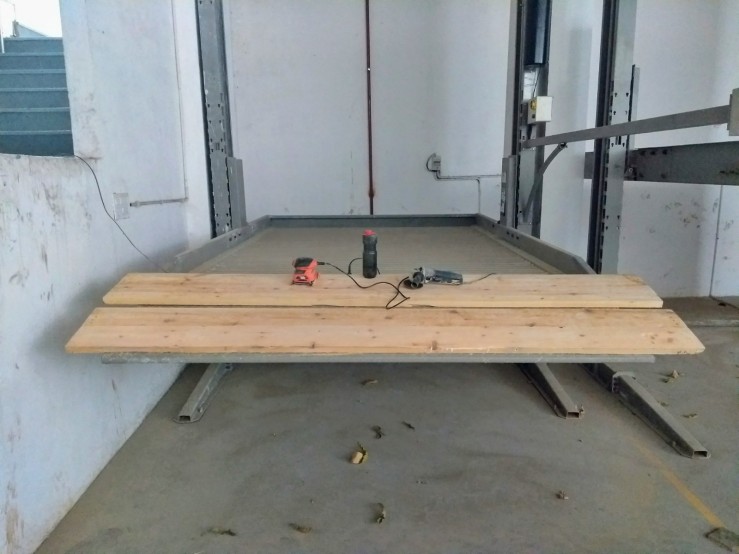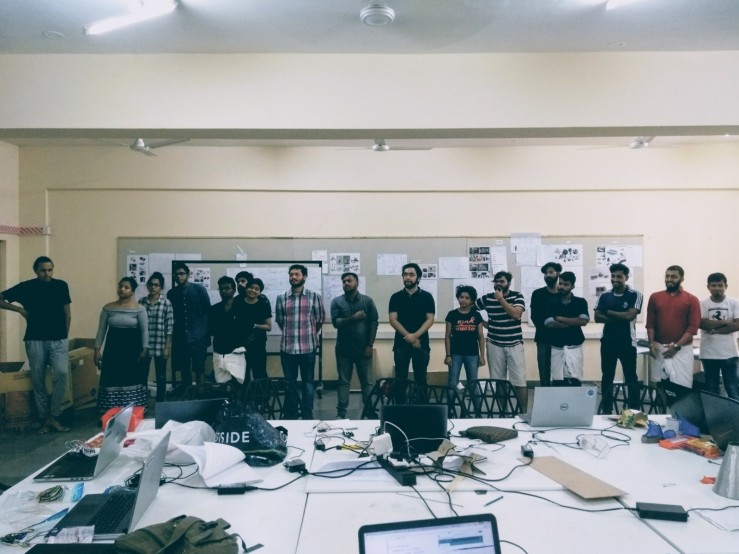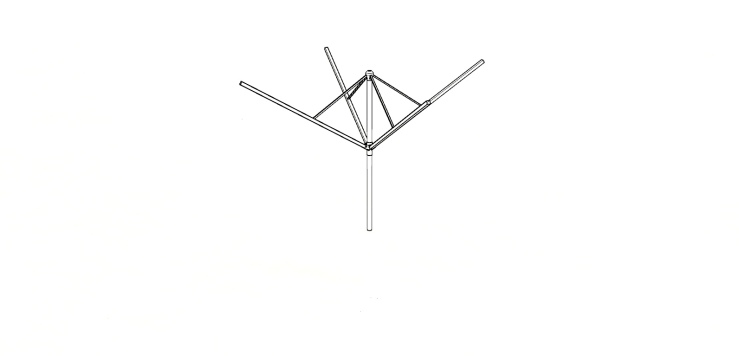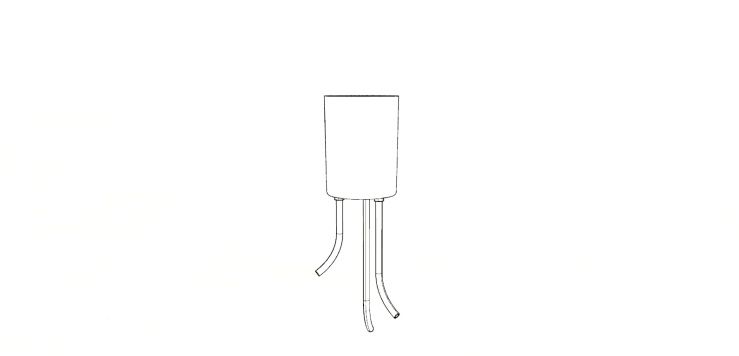It’s been a while since I blogged about a course at NID. I generally make a point of sharing my experience in a blog form. But lately, I have been super busy with things at NID and this lockdown is now giving an opportunity to write about the module I did with the talented folks of batch PDUG18 who have a bit of shit taste in music (a bit, initially :D)
I was asked if I would be interested in taking a 3 week long Materials and Manufacturing module for 4th sem 2nd year product design undergrad students. And being an tinkerer, it was one of the best learning and facilitating opportunity and I said yes to it! And coincidentally I was in the 3rd sem jury of these guys and after the jury got over I asked them for doing a brief meeting of 30-40 minutes in which they can share their expectations about the course, what would they like to explore and what are their holiday plans. I was glad that I spoke to a few and Nitya, Anvika and Amogh ended up being part of STEAM school at Maker’s Asylum.
So, the first day of the module was like any other module at NID which is spent waiting for everyone to show up. This is one thing which I still haven’t been able to decode that why it’s difficult to show up on time. Once everyone was there, we started with what is material, where does it reside, what are the properties and all the boring mundane stuff. Too be honest it did feel like a conventional class where students immediately turn into zombies the moment you as them something or what are they expecting. There’s a dead silence!
So, I thought it’s not going to work like this. I asked them that what do they think of paper (the material which we have been the most exposed during our lifetime in one form or another) and I would like to see them explore and experiment with paper. I didn’t tell them what to do, I just told them that the material is paper and told them to get going and asked them to make some quick stuff so that I can come back after some time and see what are they upto. They initial exploration to be honest were really bad and sub standard. So, I gave them the rest of the day off to make stuff and who the next day.
Next day was the same story, some people showed up with some samples and others were still in the overhang of physically being there but mentally being in some other parallel dimension. So, to get their attention, I picked up Anvika‘s honeycomb paper exploration and asked the guys to give their laptops one by one and started stacking it on the honeycomb. Most of them very sweating from inside as their Alienware, Legions and Macs were being put on top of each other. We ended up putting around 8 laptops over each other (roughly 18-20 kgs) on a honeycomb made out of copier paper. This got them excited and amazed, they learnt about stiffness of paper in an experiential manner rather than stiffness constants and compressive strength.


The overall experimentation with paper was good but it was still limited cause it was still seen as a course where someone comes talks something, asks student to produce some object and its done. It took some time for them to come out of the mindset that if a faculty has asked for 5 exploration, it doesn’t mean that you stop doing things once 5 explorations are done.
While we were talking about all this we came to a point where we started talking about minimalism, what it is, how does one object end up being minimal or dynamic or playful. These sort of off topic conversation were a normal part of class, as there was no day to day agenda but a bigger plan, it worked well. We were learning about things at pace which was comfortable. We forget that people learn at various pace and the one size fit all teaching methodology can lead to a lot of frustration, anxiety and cognitive impairment.
From minimalism I wanted to take the conversation to hand craftsmanship and Japanese master carpenters. So, we started talking about wood and what prior experience the class had with it. We came to the conclusion that basic wood joinery was not taught and we started talking about what are the different sort. I quickly took them over to an image of various joints and gave a brief idea about how it works. They we got down to the discussion of making one joinery in a pair. Hari and Kishan being over enthusiastic said that half lap joint was too easy for them, so I ended up giving them a dovetail. We ended the class in the afternoon and everyone was given a wood joint to make in a pair using hand tools only and then show it the next afternoon.
Initially people thought that how difficult would it be to take two pieces of wood, cut them a bit and join them. Big deal! It turned into one. As the prior experience was rather elementary they screwed things a bit, most of the hand tools they had needed sharpening and they didn’t know how to sharpen it. So, I was going to each group and talking to them and helping them figure out things and sharpening tools. Afternoon they were back in the studio with their wooden joineries and a smile on their faces.

We laid the different pieces on the table and started discussing what happened during the exercise. Some observations
- Huge gap between what’s in the head and what’s in the vise
- Seemingly simple things are practically difficult to make
- Appreciation for the people who deal with wood on day to day basis
- Importance of having proper and maintained tools
- Technique is important
- A lot of elbow grease is required to convert ideas into reality
- Making helps in enhancing confidence and in equipping to take bigger and more challenging tasks
There was one thing which I did mindfully during this exercise and throughout the course. I wasn’t giving them ways of doing things directly, we were watching videos, talking about processes, what worked and what didn’t. They figured out things on their own, they were creating their own paths, I was just helping them navigate.
Their enthusiasm and attention improved and they became more involved in the class rather than being the passive zombies they were initially.
I’m breaking the blog into chunks but there was continuity in our work and one thing was plugging into another. Next we started talking about what are the various manufacturing processes and everyone ended up picking one process and then they prepared 2-3 slides per person and we had a presentation the next day. I think that’s the only official presentation presentation we had.
I was also showing them the alternate ways designers are working globally and I shared the work of Dave Hakkens Precious Plastics and they seem to be interested in. So, our next assignment was to grab hold of some plastic sheets, an iron box, some butter paper and arrive into the class next day.
Next day we had all sort of plastic, colored, opaque, bubble wrap etc. Again there was no agenda beside trying to layer some plastics and see what happens. It’s like unstructured play with some goal which is defined by the person. We had people pick flowers, leaves, crayons, colored cellophane sheets, fabric, yarn, water all being sandwiched and this was being done in the studio and people could walk around and see what others were making which in turn was triggering everyone. I was playing music in the background to set a pace (this was the first time we started listening to music collectively as a class). There were so many interesting experiments being done and everyone was fully into the activity and people were freely exchanging “Abe, yeh aise kaam kar raha hai”, someone was cutting small confetti, someone was making composition, someone was putting crayon shaving as a layer and some one was creating colour interaction. After about 5 hours of experiment we put everything on the table and everyone was supposed to pick one sample they liked and one they didn’t supported with a reason. So, we shifted from actively making into actively critiquing and giving feedback. And it was made clear that critique the sample and not the person.
After this we had a break for a week as they had another module. But I kept bumping into them and talking about what’s going on. By the end of the first week, They had started taking ownership of their own learning. They were exploring and not getting into how many samples did they make, if they were done with one they started another one.
In the meanwhile we were talking about the places to go and eat. As I have spend considerably more time in Ahmedabad compared to them and being a masters student who have to stay outside I had explored the city. I told them a couple of places where they could eat. And some of them ended up going there and sending me emoticons expressing their happiness on eating at those places.
Our next session started with Leather and casting at the same time and we shifted our operations into User Centred Design Lab (It’s a long name for a lab). We got into exploring leather as a material and what are the tools, methods and processes. I do leatherworking so I had the tools which I brought to the class and I also got some leather samples I had made and explained how they were made. We started sharing inspiration boards and the objects we liked in every session. So everyone made a quick single slide on google slides with references of products they liked and which among them would they like to start with. The slides were also populated with memes in between which made the exercise of going through these informal presentations more fun and engaging. Sometimes laughing at Memes in a classroom can bring people together. After they had made up their mind we got into sourcing of materials, they went in groups to get leather, hardware and other things. Nitya and Pranav didn’t want to work with leather and they backed their choice by valid reasons. So, we started looking at alternatives, I had known that there is a store which sells Tyvek and it could be an interesting material to explore, also cork was shortlisted. These guys went to the store and somehow managed to get free samples and they also got duped by a guy who sold them some cheap quality weird plastic as cork. Once all the material was in the lab these guys got into figuring out patterns and other things. They handled the material really well and did all sort of explorations. One of the thing which I had to demonstrate to everyone was saddle stitch and how to burn off the thread after stitching is done.
One of the main learning from this exercise was material sourcing and how to figure out alternatives.
As they were making the leather objects another exercise was introduced. They had to make two positives for casting and the constraint was that it needs to fit within a 7cmx7cmx7cm volume. They again shared inspiration boards and the objects they liked . They finalized the objects and in between started making them. They used different materials like mseal, mdf, polystyrene etc. They were multitasking and figuring out how to take care of things simultaneously. On the last second last day we put some of these positives into silicone to make some moulds. Working on a small scale can be challenging and when making objects for casting it becomes important to factor in things like the parting lines, draft angle, undercuts etc.
We also had a brief presentation by a WPC manufacturer during the course.
This exercise helped them visualize things in 3 dimension and from a specific perspective of spatial orientation of the object.
Paper Weaving Workshop by Mayur Bhalavi
I wanted to expose these guys to a slower process which is labour intensive and needs cooperation. Mayur has been working with paper for a couple of years now and teaches self help women group how to make objects out of waste newspapers using various techniques like coiling, paper tube weaving, forming etc. So, this workshop introduced them to what happens when a design process is intuition driven where the end user could be the designer him/herself. The venue of this was shifted to Foyer where these guys took up the space and Mayur got down to explaining them the process of making paper tubes out of newspaper, then joining them and ultimately weaving baskets out of them. Mayur finished his workshop with sharing his design process, inspiration, work he does with the women basket makers and ideology. After that everyone applied a coat of varnish to protect their baskets. In this workshop they learnt an alternative way of practicing design which is more participatory in nature. We all went to Noorani to have food at night and then to Sheetal for having ice cream. It was pretty fun.
In this workshop they learnt an alternative way of practising design which is more participatory in nature.
The Final exercise they had was to make a music instrument. That’s it. I didn’t tell them what I was expecting or what works and what doesn’t and by now they were a bit used to getting open ended briefs. They were a bit puzzled in the beginning and they we saw a couple of videos of people making simple music instruments. They started slowly and started exploring various materials. They were trying to check every material for its acoustic properties. Someone was hitting a piece of bamboo with a stick, someone was making clay bodies with stones inside, someone had a stretched rubber on top of a bamboo section. It was a chaos, they were making so much noise that when one was walking in the wood workshop they could clear hear the incoherent noise coming from Science lab. This went on for 3 days and eventually they fine tuned their ideas and instruments. We wanted to have a small performance but due to lack of time we couldn’t. We ended up with some pretty good looking and sounding instruments.
This exercise was sort of a culmination of whatever they learnt in the past weeks. Cause making an instrument is not a simple thing, it involves a lot of material properties.
On the last day we didn’t work, we saw some videos in the morning and spoke about design in general and what works and what doesn’t. After lunch we put all the things which were made on the table and started arranging. Once everything was arranged everyone was told to go around the tables and pick one object which they thought was well executed and one which they thought could have been better. They took some time as the number of things on the table were a lot.

Then we sat down and set a guideline that we are critiquing the object and not the person who made it. They gave a reason for the well executed and the one which could have been better. This was just a warm up for what was coming next. As these guys have known each other for almost two years, they still didn’t know their strong traits and things which needed to be worked upon. So, one by one everyone told each others these points, it took almost 4 hours. And at the end of it people cleared a lot of things which were in their mind. They were being open to each other and telling things without feeling judged.
And finally to finish off a course grades need to be given. So, these guys had to grade each other as a class. I asked them if everyone should get the same grade or different. They unanimously said that it should be the same for everyone as from the beginning of the course it was said that the purpose of this course is to learn and not to compete with each other and everyone was supposed to help each other and set benchmarks, which they did. And it seem like a good reason for getting same grade. I wrapped up the class with giving my feedback to everyone, they already had covered most of the points when they gave feedback to each other.
Things which we learnt in the modules:
- The learner should set realistic goals they want to achieve and the faculty has to facilitate them in doing that.
- People learn the most when the learning is highly personal. Though the briefs were same for everyone, they ended up coming with things which they held close to them.
- Ownership of the process should reside with the learner and not the facilitator. If you cannot own your own work and process then the learner ends up doing things for the sake of doing them.
- This module was to give Designers an orientation of engineering, materials, manufacturing processes and practices. It aim was not to make them engineers. I didn’t expect them to become engineers in 3 weeks and understand all the technical know how. Designers use materials very intuitively and in a tactile way. We did talk about technical terms and there meaning but they went around exploring the properties in an experiential way and not theoretical.
- The facilitator needs to create an ambience of experimentation in these sort of courses. There should always be plan B. People should feel comfortable asking questions, trying things out and failing. The process should be given importance rather than the final outcome. Though we never gave importance to the objects, we did end up with a varied and extensive exploration.
- The goal of design or any sort of education is to make sense of the world. They were doing a process of sensemaking through experimentation and explorations.
- The facilitator needs to be updated with the present practices, processes, materials, technologies, memes (really important).
- We were playing music most of the time and it was one thing which brought a lot of people together. They were not only exploring things but they were having fun and enjoying the process. As Oki Sato of Nendo said “The word FUN is in the term Function”, having fun is really important otherwise things become too mechanical and mundane.
- I had numerous conversation about my own experiences and how everyone has their own design process which they need to figure out and it can be emergent and evolving rather than being the standard IDEO method. As these are undergrad students it was interesting to talk about what they think about the world and how they view it. We spoke about food, books, music, meaning of life, our purpose on this planet, anarchy etc.
- It would not have been possible without the participation from both they sides. It took a lot of effort to be there most of the time and engage with them actively and I think it was one of the good experiences of being at NID.
- Age doesn’t define someone’s knowledge and everyone has something to offer.
What some of these had to say about the module (They were asked to write a 1500 word writeup)
The learning in the course was done with the aim of trying of what I could do if I had no limitations which is very important for a designer to design and which doesn’t let him or her do it only for the sake of an assignments. It was a course which had freedom of doing what you believe in.
For me learning about materials by making objects out of them has been an apt approach. One can always read about a 100 different materials and still don’t know about the behavior of any one of those as they must not have tried working with those materials.
Not striving for a set outcome but rather choosing something that I like to do is an equally valid process to follow. Simply put, it is a lot more enjoyable.
The idea of making objects with your own imagination figuring out the process and decoding the steps required to do so is the part that is most enjoyable.
It taught me importance of group working and creating an working environment, the importance of hands on experience of materials and objects, the sensitivity to handle materials within their parameters and still get some outcome and also the importance of believing that you can do it and that things can be figured out if thought about logically and rationally.
In the end it was a celebration of us playing with materials. Having fun. Watching videos that has nothing to do with Materials and manufacturing.
Materials and manufacturing, sounds like a technical course isn’t it? But who knew these
three weeks would be one hell of an experience, one that would be filled with fun,
enthusiasm, knowledge, music and of course materials.
Knowing about a material through the internet or through any written content,
and knowing the material by actually working on it is totally different. So hands-on approach played an important role in the course.
A lot of other things were said but that is protected under faculty – student confidentiality 😀
I had an amazing time with these guys. They are a bit better equipped to take on the world and I know they will do good work.





















































































































































































































































































































































































































